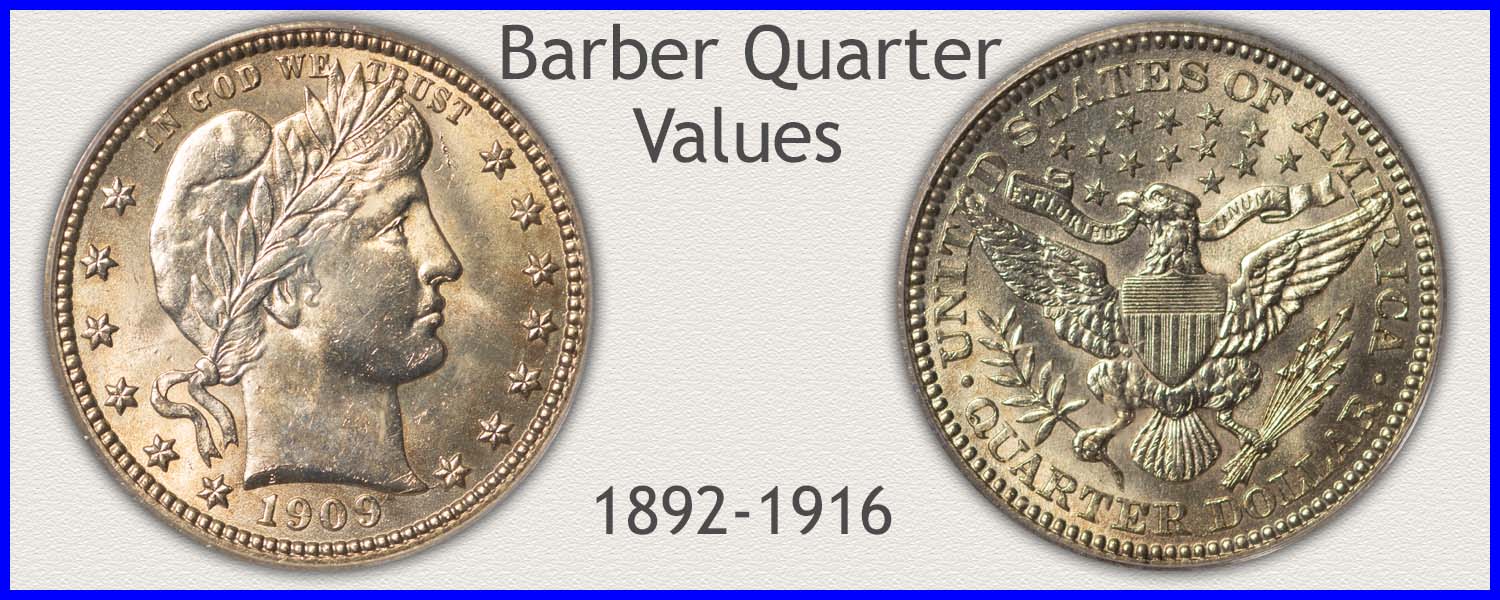Coin Values Moving with Precious Metals: Up-Dated 12/22/2025: Gold $4413 | Silver $68.92
1895 Quarter Value
Now an older, vintage series of coinage, 1895 quarter value is narrowed by identifying the mint issue and then condition. These quarters are valued at least $16.64 each, this is the starting point. Additionally, all have a good potential to climb higher.
When it comes to those minted in the early years of the series, the coin's condition is important. Today, many are still available, but the majority are heavily worn. A premium example is just lightly worn or even nicer in appearance, with most of the original detail very crisp.
An important step in determining out how much these quarters are worth is evaluating their state of preservation. See section: 2, How to Grading Condition
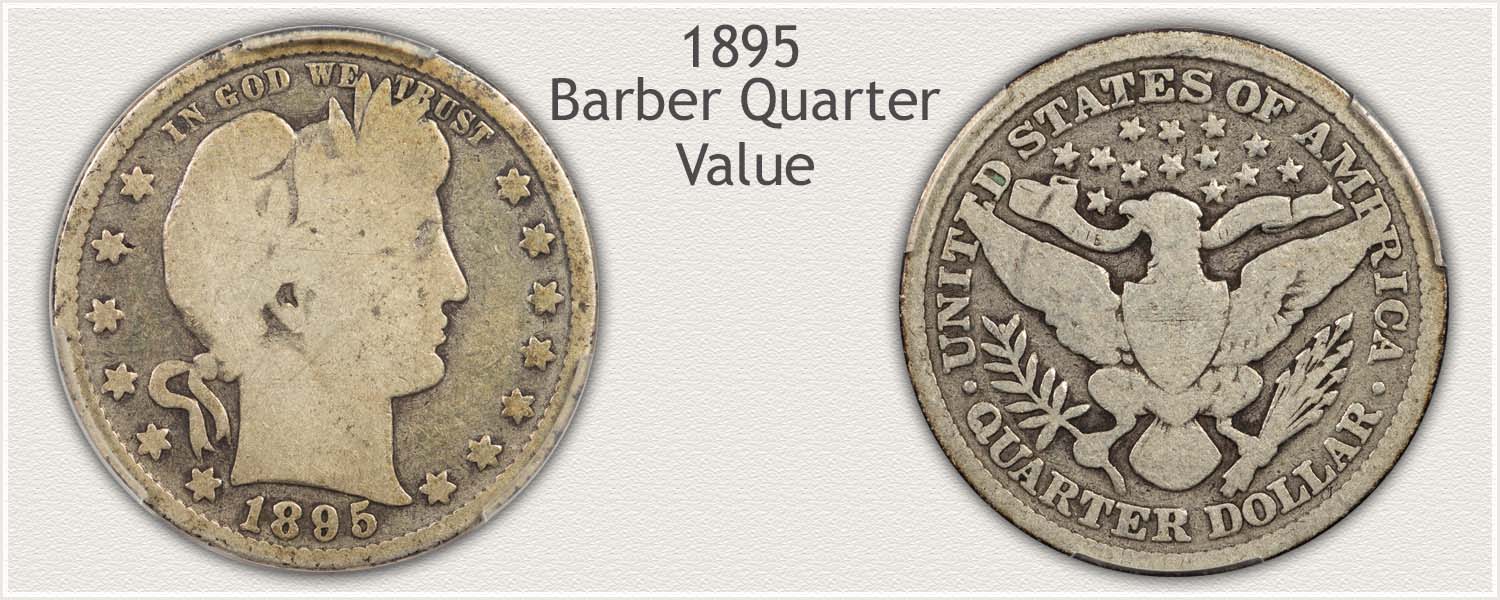
Steps Leading to Value:
- Step 1: Date and Mintmark Variety - Recognize popular date/mintmark combinations of 1895 quarters and locate correct listing on chart.
- Step 2: Grading Condition - Collectors determine whether to add a coin to their collection depending on how well it has been preserved and how much detail is still visible. Grade the condition of your coin.
- Step 3: Special Qualities - Following is a general quality overview of these Barber quarters. Collectible coins without eye-distracting nicks and marks are preferred by collectors and dealers.
| 1895 Quarter Value | ||||
|---|---|---|---|---|
| Condition of Coin | ||||
| Date | Good | Fine | Extremely Fine | Mint State |
| Barber Quarter Values Updated | 12/22/2025 | |||
| 1895 | $19.16 | $34 | $61 | $315 |
| 1895 O | $23.19 | $42 | $101 | $809 |
| 1895 S | $20 | $109 | $186 | $464 |
Above is a starting point helping determine a wholesale value of your Barber quarters. Follow the steps to narrow the range of subtle grading points.
Step 1: | Date and Mintmark - Three Different Varieties
Popular Mint Variety Quarter
A popular and in-demand mint variety of 1895 leads the market in value. Issues from the San Francisco mint often saw the fewest quarters struck in relation to the annual total during the course of the Barber quarter series.
On coins struck by the branch mints, each mint variety is valued independently and is recognized by its mintmark. Examine and note the correct date and mint combination using the images below.
1895-S Barber Quarter
"S" Mintmark on Reverse: San Francisco Mint Struck the Coin
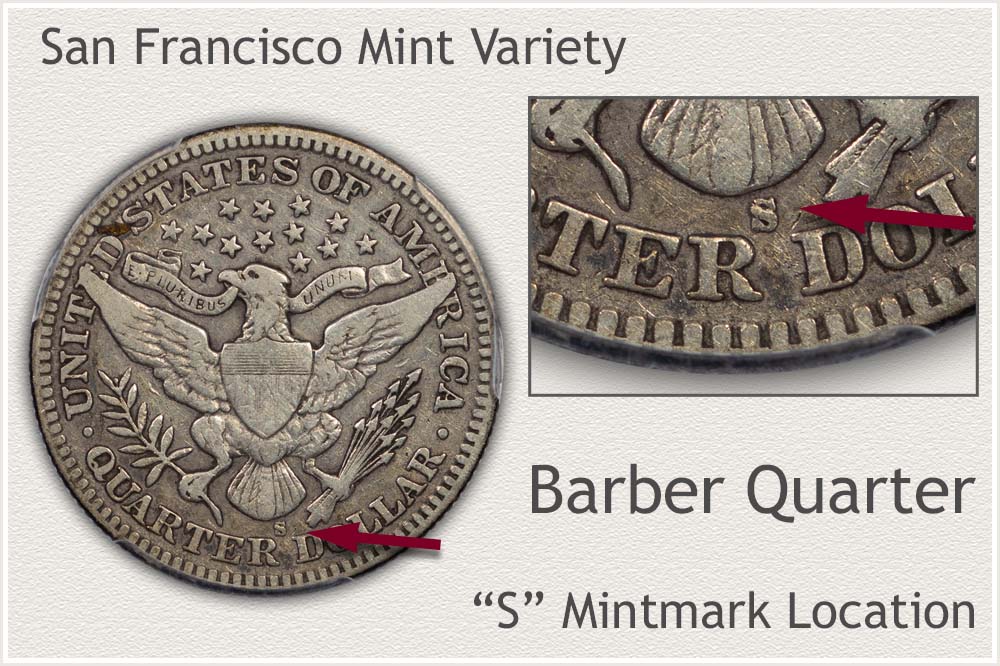
A challenging coin to locate, collectors are the support to high premiums of the San Francisco 1895 quarter. The other mint varieties of the year were produced in greater numbers than San Francisco's 1,764,681 pieces.
Heavily worn examples of these quarters are somewhat available; however, nicely detailed coins are very difficult to find. Setting aside coins and placing them in collections at the time was not done to a large extent, few remain today in high-end condition.
The "S" mintmark on the reverse confirms the mint type. Between the lettering of "Quarter Dollar" and the bottom edge of the eagle's tail feathers, a "S" mintmark identifies the coin was made in San Francisco.
1895-O Barber Quarter
"O" Mintmark on Reverse: New Orleans Mint Struck the Coin
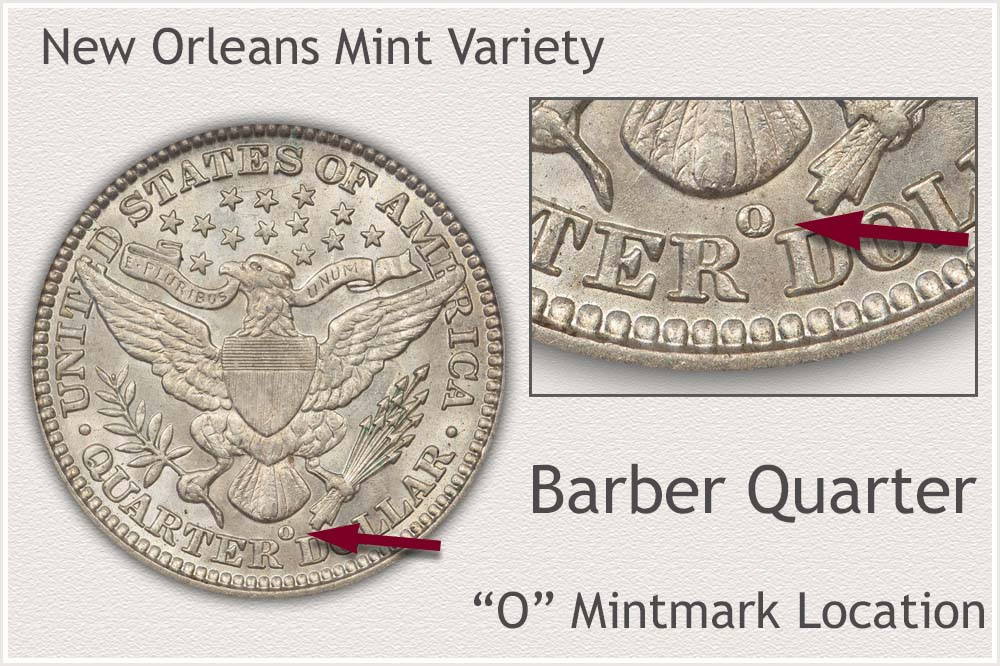
With a focus on serving the center of the nation, the New Orleans mint played a significant role in the 1895 introduction of the Barber quarter series. New Orleans, together with the Philadelphia mint, produced the majority of quarters during the year, New Orleans minting 2,816,000 pieces. A coin with exceptional detail is a valuable collector's item. In addition, the value of worn pieces is often slightly higher than the value of the silver itself.
To distinguish the various mining facilities, branch mints add mintmarks to their coinage. The New Orleans mint's mark, a letter "O," is seen on the reverse of the example quarter.
Find the New Orleans mintmark above "Quarter Dollar", between the letters "R" and "D." An "O" just beneath the eagle's tail feathers identifies the coin as produced in New Orleans.
1895 Barber Quarter
No Mintmark on Reverse: Philadelphia Mint Struck the Coin
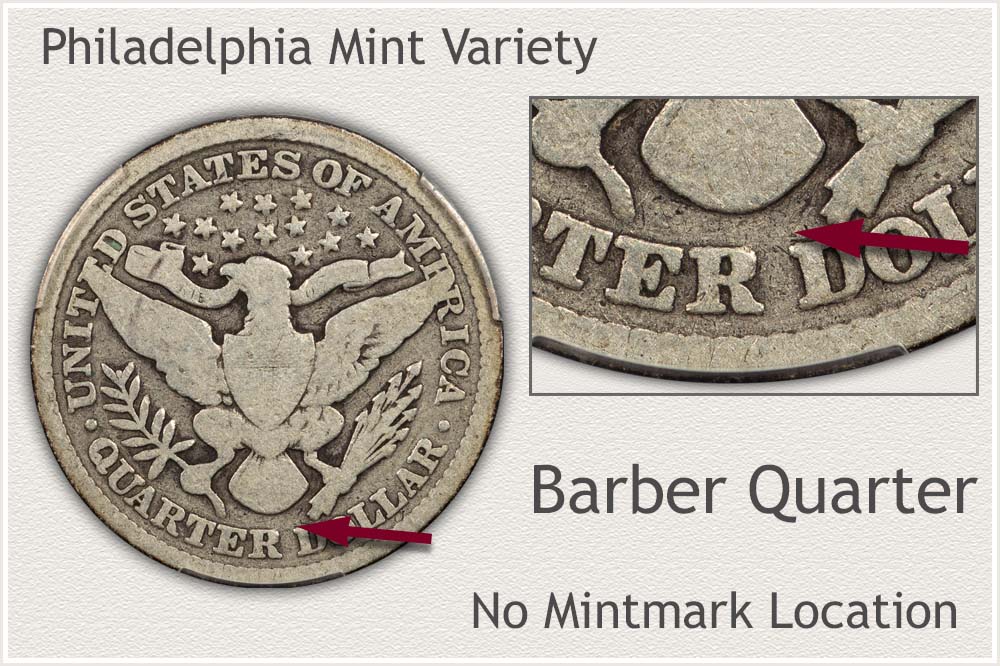
During the early era of the Barber series, the Philadelphia mint established itself as the leader in production. 1895 total mintage of quarters was 4,440,880 pieces. An available coin today in heavily worn condition.
Values of examples at the low end of the condition scale are tied to their base silver price. Popularity of the date is supported as part of a long obsolete series and a nineteenth century date. These are now very old coins.
Verify the mint variety by the absence of a mintmark on the reverse. Philadelphia quarters of the Barber series are without a mintmark. Towards the lower part of the coin, above "Quarter Dollar," if the space is empty, it confirms Philadelphia struck the coin.
Step 2: | Grading to Recognize Important Features of Condition
1895 Quarter Value is Narrowed by Accurate Grading
The amount of wear found on coins follows recognizable stages. As high points of the design are removed by wear, distinct changes accrue to the remaining design. These visual changes are used to recognize the different grades.
Beginning with a coin in as-new condition, shows all original detail intact when it was first minted. Compare to the images showing stages of wear to assign a grade.
Mint State Grade
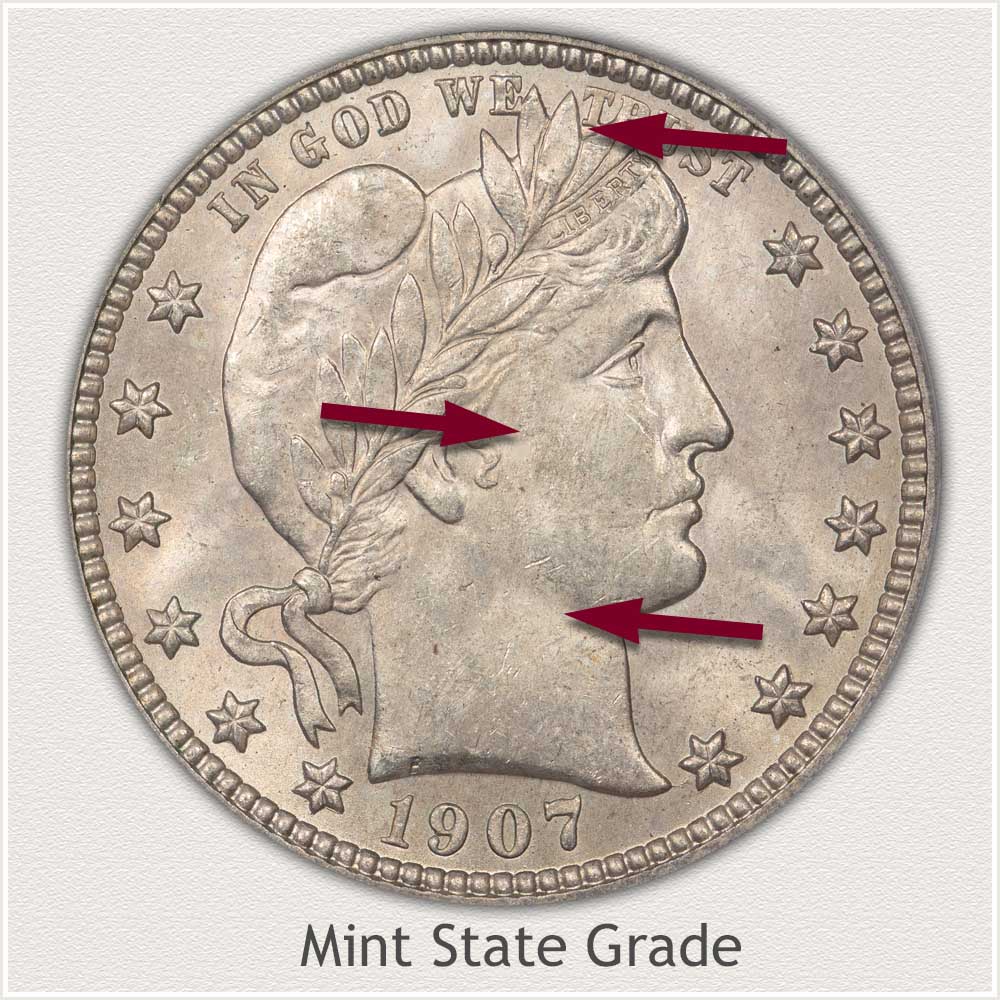
Mint State: A complete lack of any wear disturbing the luster on the surface of a coin defines the Mint State grade. Coins in this condition never circulated and became worn. A Barber quarter without wear remains with luster on the high points of the design.
Looking at Liberty's cheek, notice the texture of the surface is similar on the raised parts of the contour as well as the lower areas. Luster shines from both the high points and low points.
A close inspection of the laurel leaves, forming the wreath within her hair, shows no flattening of the leaf edges due to wear and removal of metal.
When viewed overall, a nice shine is full and spreads across the surface of the coin as it is rotated under a light.
Extremely Fine Grade
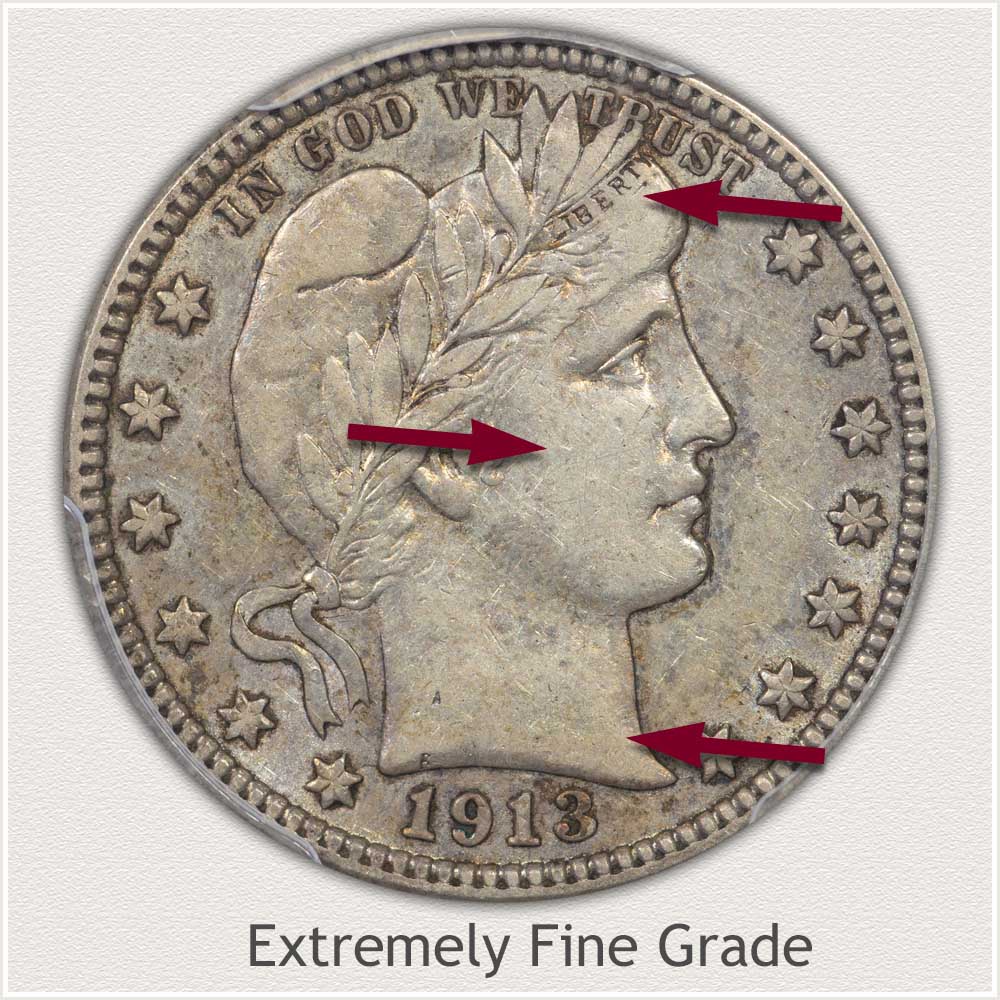
Extremely Fine: Barber quarters are now a very old obsolete series. Examples found with just minor wear are scarce and highly collectible. Condition of these coins with wear confined only to the high points of the design is termed and defined as Extremely Fine grade.
The amount of wear and the loss of detail are judged using specific areas of the design prone to early wear. Firstly, the headband within Liberty's hair is very high in profile. Wear appears here first, and the condition of the lettering and band are used to judge the extent of metal removal. Placing the example well within the grade is the strong lettering of "LIBERTY" across the band. All letters are complete, and the majority of the lower edge of the band remains distinct.
Liberty's face and neck area are just slightly smoothed, with a roundness apparent to the contours. When viewed overall, the entire coin's design is well detailed, showing many fine lines in the hair near the ribbon and knot and leaves of the wreath. Handle these high condition coins by their edges to maintain their level of preservation.
Fine Grade
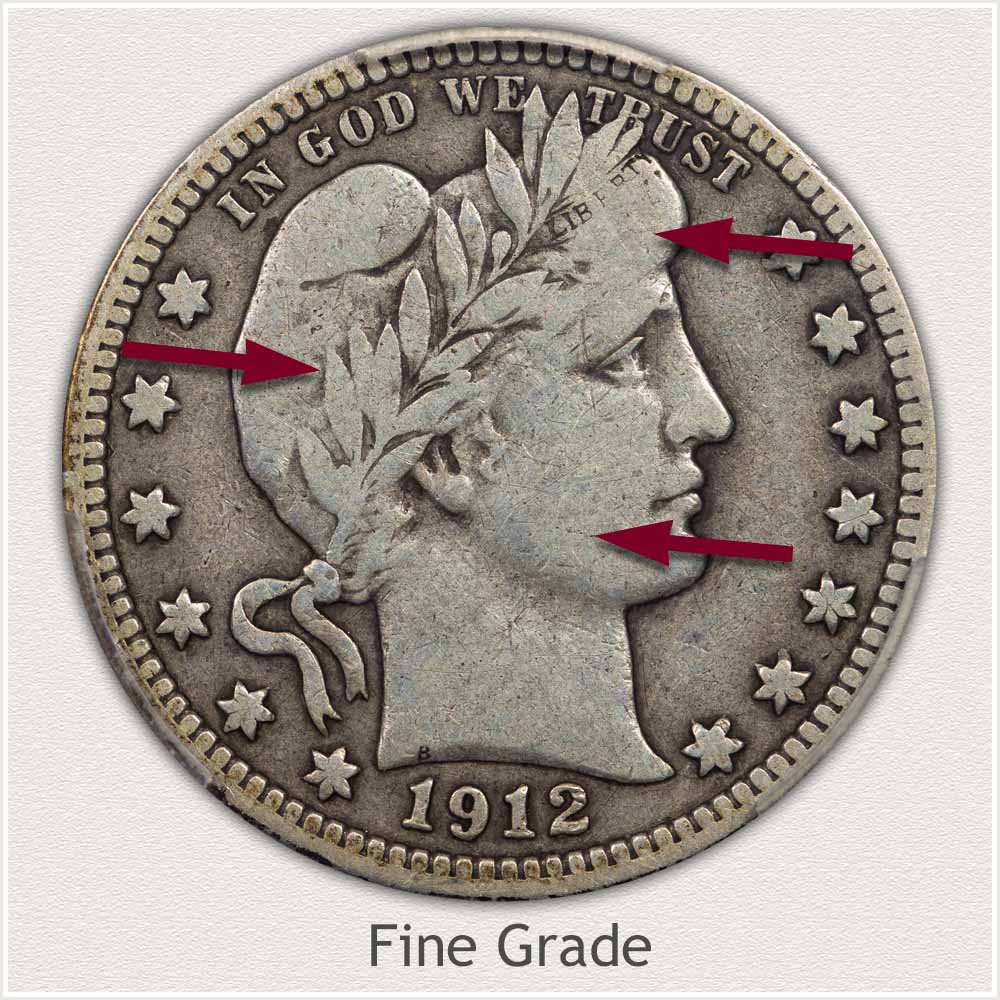
Fine Grade: Judging a Barber quarter in Fine condition identifies a collectible quality coin. A couple of key design elements are closely inspected to recognize remaining details. Moderate wear overall is what defines the Fine grade.
Time in circulation reduces high points of the design by wearing through the depth of these details. Above Liberty's forehead, her hair is one of the highest areas on the coin. Fine grade is determined when the hair has lost the details of its fine strands. Also, the lower line of the headband is missing and blended with her hair.
Another feature of the grade is the condition of the leaves within the wreath. All have been reduced to a smooth, flat surface. No inner detail of the leaves is visible. Important to maintaining the grade is the edges of the upper row of leaves are visible. Small areas where leaves overlap are slightly blended, with many leaves still boldly represented.
An ample amount of design remains, giving the overall appearance of quality.
Good Grade
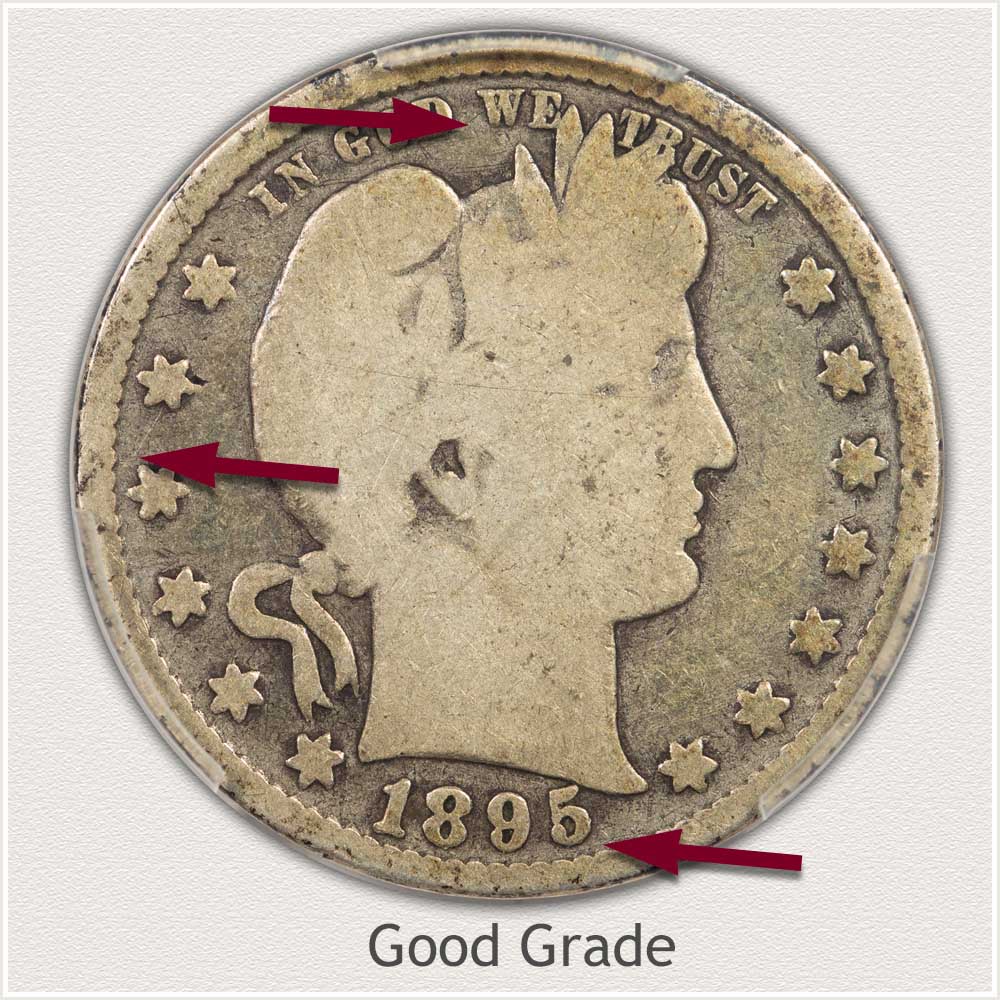
Good Grade: Three main features are placing the example coin in a solid Good grade range. First, is the portrait is fully outlined and bold from the field. Wear has smoothed all small details of the portrait, leaving a flat outline of Liberty. Secondly, a distinct rim and stars remain. Finally, a very readable date.
Wear flattening the main devices to a flat surface defines the Good grade. Inspecting the upper part of the portrait, all edges of the leaves are complete, no blending with rim or lettering. Additionally, a full inner edge to the rim is defined and separate of all points to the stars. A nice bold feature of stars and rim forming a frame to the portrait.
The all-important date is also disconnected from the rim. Any added wear lowers the rim and begins merging with the numerals. As a result, any merging lowers the appeal to collectors. Overall, a nice representation of an old quarter.
How to Video: Grading Barber Quarters
Focus on specific areas during the grading process by following the video and images. Key elements are inspected and used to confirm the quality of a coin's surface and extent of wear on these vintage quarters.
Video, Images and Descriptions | Grading Barber Quarters
Step 3: | Special Qualities | Free of Marks
Damage Free Surface Adds 1895 Quarter Appeal
One of the positives of the Barber Quarter Series is the ability of new and beginning collectors to participate. A complete date run, one coin representing each year, is a worthy set and popular. All but two of the Philadelphia issues, 1905 and 1913, are very affordable in Good or slightly better condition. 1895 is an example of an affordable early year. Ample supplies of all years are available to collectors, providing a large selection.
With the long amount of time in circulation, many of the quarters received damage in a variety of forms. A close examination is an early skill learned by collectors, and they inspect both obverse, reverse, and rim of all coins for damage.
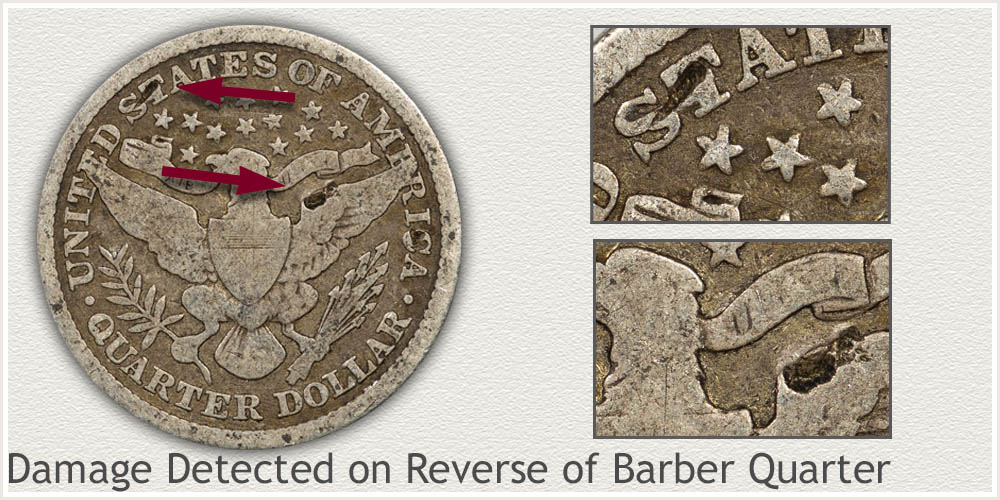
The reverse of a Philadelphia Barber quarter is displayed above with a nice overall appearance. From a distance, the toning is highlighting the devices and forming a slightly deep background shade. It is when a close-up exam is made, the three distracting marks are very noticeable.
A high premium Philadelphia quarter is lowered in value considerably if found with damage. The possibility of this coin entering a collection representing any of the Philadelphia issues is remote because of the noticeable damage marks.
Collector quality includes eye appeal in all stages of wear, from heavy to light wear to mint state examples. In any grade, absence of distractions is a large positive. High quality is scarce.
References
U.S. Mint. 1896 U.S. Mint Annual Report
https://nnp.wustl.edu/library/book/514118
U.S. Mint. Catalogue of Coins of the United States.
https://nnp.wustl.edu/library/book/554591
Coin Values | CoinStudy Articles
Date by Date
In Depth Barber Quarter Values
1892 to 1916
Barber Quarter Value | Many In Demand Dates
Different condition coins are valued separately, also the many dates and mints of Barber quarters range from common to scarce to very rare. Complete value chart of all dates and mints with condition ranges are listed. All dates of the series are in demand.
Old Coin Value | Images Identify Varieties
Quarters along with the other denominations of U.S. coinage were minted in many different designs over the years. Matching your coin to images identifies the correct design variety. Links to each series including value charts, and coverage of how to place a value on old coins.
Print the Coin Values Worksheet
Organize Barber quarters on the worksheet by dates and mints along with condition and values. Record your entire group of old coins in one reference place.
Safe Coin Storage | Recommendations
Select from a variety of options to safely store, maintain, and house Barber quarters and the rest of your collection of coins. Specific recommendations are made to hold single to many coins in a protected manner.
The U.S. quarter denomination was introduced in 1796. Many dates of the early years are very rare and most are scarce and highly valued. Beginning with Seated Liberty series, collectors find difficulty in completing sets because of the rarity of many date and mint examples. Barber quarters are represented, Standing Liberty and Washington series all have coins with potential.
Silver is a market moving daily, upward or lower. Many Barber quarters in heavily worn condition trade based on their silver worth. Identify the U.S. coin series produced in the now valuable silver alloy. Calculate current values and refer to the listing of dealers involved in buying bullion quality silver coins.
Coin Grading Services | Professional Review of Condition
Grading of Barber quarters can lead to recognizing coins in the over one hundred dollar value range. With large premium coins; subtle points to condition are very important to judge accurately. The top two grading services NGC and PCGS authenticate and grade coins, providing a market accepted judgment of condition.
★Coin Values Discovery finds 1895 Quarter Value and...
All old U.S. coin values. The home page Introduces the important steps in the value process. Identifying your coin series, accurate date and mint, and images to compare when judging condition. Key elements are noted to narrow a range of how much these old coins are worth.
